Ever heard the saying, “Roses are red, violets are blue”? Well, in my garden, it’s more like “Roses are red and lavender too”. You see, Growing Lavender with Roses is something of an art form that I’ve been perfecting over the years.
It’s not just about throwing seeds into the ground and hoping for the best. It requires a bit of knowledge, a pinch of patience, and a whole lot of love. But don’t worry! I’m here to share some tips that have helped me along the way. So keep reading about 5 Tips for Growing Lavender with Roses.
Key Takeaways
- Lavender and roses can be grown together due to their similar sunlight and soil needs.
- Plant lavender around roses to deter pests, as its scent is a natural repellent.
- Ensure good drainage for both plants, as neither likes waterlogged roots.
- Prune both plants regularly to promote healthy growth and prevent disease spread.
- Feed roses with rose food but only use general-purpose fertilizer for lavender.
Why Grow Lavender with Roses?
Ever wondered why growing lavender with roses is a thing? Well, it’s more than just about the aesthetics. It’s about boosting plant health and keeping those pesky pests at bay.
The Benefits of Companion Planting
Companion planting, folks, is like the Tinder for plants. It’s all about finding that perfect match to enhance growth and keep each other healthy. And when it comes to lavender-rose companionship, it’s a match made in garden heaven.
You see, these two aren’t just pretty faces. They work together to improve each other’s health and growth. Plus, they’re natural pest deterrents. So you won’t have to worry about those annoying bugs ruining your beautiful garden.
How Lavender Complements Roses
Now let’s talk specifics – how does lavender complement roses? Well, first off, they share similar growth conditions. That means they enjoy the same soil type and sunlight exposure.
But what really makes them a power couple is their aesthetic pairing. Imagine this: The vibrant purple of lavender contrasting with the rich red of roses. Now that’s an Instagram-worthy garden right there!
So next time you’re planning your garden layout, consider growing lavender with roses. Trust me; your garden (and Instagram followers) will thank you!
What are the Ideal Conditions for Growing Lavender and Roses Together?
When it comes to co-planting lavender and roses, there are a few ideal growing conditions to keep in mind. These include understanding soil requirements, sunlight needs, watering habits, and climate considerations.
Understanding the Soil Requirements
Both lavender and roses love well-draining soil. The key is finding a balance between moisture retention and drainage. Too much water can lead to root rot, while too little can leave your plants thirsty.
The pH levels for plant growth also play a crucial role. Lavender thrives in alkaline soil with a pH of 6.7 to 7.3, while roses prefer slightly acidic to neutral pH levels around 6.0 to 7.0.
Lastly, let’s talk about nutrient content in soil. Both plants need rich soil packed with nutrients for healthy growth. But remember, over-fertilizing can do more harm than good!
Sunlight and Watering Needs
Sunlight is like food for plants – they need it to grow! Both lavender and roses require full sun exposure, so aim for at least six hours of direct sunlight daily.
Watering frequency for lavender and roses differs slightly due to their individual needs. While roses enjoy regular watering, lavenders prefer their roots on the drier side.
As for the appropriate water quantity for plants, it varies based on factors like climate and soil type. However, a general rule of thumb is that it’s better to underwater than overwater these beauties.
Climate Considerations
Climate effects on plant growth cannot be overlooked when growing lavender with roses together. Both plants enjoy warm climates but can tolerate different temperature ranges.
Lavender is quite hardy and can withstand temperatures as low as -10 degrees Celsius! Roses, on the other hand, prefer milder winters where temperatures don’t drop below -5 degrees Celsius.
Lastly, seasonal changes impact on plants is also significant. Both lavender and roses go through a dormant period in winter, which means they require less water and care during this time. But come spring, they’ll be ready to bloom again!
How to Choose the Right Varieties of Lavender and Roses?
When choosing lavender varieties and selecting rose types for companion planting, it’s crucial to consider a few factors. First off, your local climate plays a big role. Both lavender and roses love the sun, but some varieties are more cold-hardy than others.
Next up is soil type. Lavender prefers well-drained, slightly alkaline soil, while roses enjoy rich, loamy earth. You’ll need to find a happy medium if you’re growing lavender with roses.
Lastly, don’t forget about your personal preferences! After all, you’re the one who’ll be enjoying these beautiful blooms.
Best Varieties of Lavender for Companion Planting with Roses
So which lavender varieties for companion planting should you go for? Well, English Lavender (Lavandula angustifolia) is a classic choice. It’s hardy, has beautiful purple flowers that contrast nicely with most roses, and its growth habits mesh well with many rose types.
Another great option is French Lavender (Lavandula stoechas). Its unique butterfly-like blooms add an extra layer of visual interest when pairing lavender with roses. Plus, it’s pretty easy-going in terms of care needs.
Best Varieties of Roses to Pair with Lavender
On the flip side, when considering rose types for companion planting, think about color contrast and fragrance synergy. For instance, red or pink roses provide a stunning contrast against lavender’s cool purple hues.
Fragrance-wise, Old Garden Roses have a sweet scent that harmonizes beautifully with lavender’s calming aroma. In terms of maintenance compatibility when pairing roses with lavender, Shrub Roses are relatively low-maintenance and can thrive alongside different types of lavenders without much fuss.
What are the Steps to Plant Lavender and Roses Together?
When it comes to planting lavender with roses, there’s a bit more to it than just digging a hole and dropping in the plants. It’s all about preparation, planting procedure, and spacing considerations.
Preparing the Garden Bed
First things first, let’s talk about preparing your garden bed. You see, both lavender and roses love well-drained soil. So, start by adding some organic matter or compost to your soil. This will improve its texture and drainage capabilities.
Next up is pH level. Roses prefer slightly acidic soil while lavender thrives in neutral to slightly alkaline conditions. A pH of around 6.5 should keep both plants happy.
Finally, set up your garden bed in a sunny spot because these beauties need at least six hours of sunlight each day. Now that’s what I call preparing ground for planting!
Planting Procedure for Both Plants
Now onto the fun part – planting! When planting lavender with roses, start with the roses first as they’re larger. Dig a hole wide enough for the root ball and deep enough so that the bud union (the swollen part of the stem) is level with or slightly above the ground surface.
For lavender, dig a hole that’s roughly twice as wide and just as deep as its root ball. Place your plant in so that it sits at or just above ground level.
Remember to backfill both holes gently but firmly without compacting the soil too much around roots.
Spacing Considerations
Lastly, we need to consider spacing when growing lavender with roses. These plants need room to breathe! Aim for about 3 feet between each rose bush and 1 foot between each lavender plant.
This allows good air circulation which helps prevent fungal diseases common in crowded gardens. Plus, it gives them space to grow into their full, beautiful selves. So there you have it, the plant spacing guidelines for a happy garden!
How to Maintain a Healthy Coexistence Between Lavender and Roses?
When it comes to growing lavender with roses, maintaining a healthy coexistence is crucial. This includes mastering the art of pruning, implementing effective pest control measures, and understanding their unique fertilization needs.
Pruning Techniques for Both Plants
Pruning is an essential part of maintaining plant health. For lavender, it’s all about timing. Prune in early spring before new growth starts but after the risk of hard frost has passed.
For roses, it’s a bit more complicated. You’ll want to prune in late winter or early spring when the buds start swelling but haven’t opened yet. Remember, every cut you make will influence the shape and growth pattern of your rose bush.
Pest Control Measures
Pests can be a real pain in the neck when trying to maintain a lavender rose garden. But don’t fret! There are plenty of organic pest control methods that can help protect your plants.
For lavender, try using a spray made from water and mild dish soap to deter aphids and other pests. For roses, consider introducing beneficial insects like ladybugs into your garden who love munching on common rose pests like aphids.
Fertilization Needs
Fertilizing is another key aspect of plant health maintenance when growing lavender with roses. Lavender prefers poor soils with low fertility so over-fertilizing can actually harm them.
Roses on the other hand are heavy feeders and thrive with regular feeding throughout their growing season. Consider using organic fertilizers for plants that are high in potassium to promote blooming while ensuring overall plant health.
To Wrap Up
In the dance of horticulture, Growing Lavender with Roses is like a tango between a rose and a lavender sprig. They dazzle in their own ways but together, they create an enchanting spectacle.
Remember, roses are the divas needing center stage while lavenders are the backup dancers adding depth to the performance. So, let’s get our green thumbs dirty and make our garden a floral paradise!





